Affiliate Disclosure: PantryBrands.co.uk is a participant in the Amazon.co.uk Associates Programme. As an Amazon Associate, we earn from qualifying purchases made through links on this site.
Teriyaki sauce is a sweet-savory Japanese-style condiment that has gained worldwide popularity for its rich glaze and versatile use in cooking. Made from soy sauce, sugar, and mirin (or similar sweeteners), it delivers a balanced umami flavour that works well with meat, fish, and vegetables. This guide covers its uses, nutrition, varieties, and how to pick the best quality.

Teriyaki Sauce Uses Beyond Stir-Fry
While stir-frying is the most common use, teriyaki sauce can do much more in the kitchen.
- Grilling & Roasting – Brush over chicken, salmon, or beef for a glossy, caramelised finish.
- Glazing Vegetables – Coat mushrooms, aubergines, or carrots before baking for a sweet-savoury depth.
- Burgers & Wraps – Add a drizzle to chicken or beef burgers for a Japanese fusion twist.
- Rice & Noodle Bowls – Toss with cooked rice or noodles for quick flavour enhancement.
Teriyaki Sauce Nutrition Overview
Like many sauces, teriyaki brings both flavour and calories, mainly from sugar.
- Calories – Around 20–25 kcal per tablespoon (15ml).
- Sugars – 2–4g per serving, depending on brand and style.
- Sodium – 300–600mg per tablespoon, due to soy sauce base.
- Nutrients – Small amounts of minerals from soy sauce, but not a significant source of vitamins.
Tip: If you’re watching sugar intake, look for reduced-sugar versions.
Trusted UK Teriyaki Sauce Brands
Several brands offer quality teriyaki sauce options in UK supermarkets.
- Kikkoman – Naturally brewed with balanced sweetness.
- Blue Dragon – Widely available and affordable, ideal for everyday cooking.
- Stir Crazy – Premium small-batch sauces with fresh ingredients.
- Tesco & Sainsbury’s Own-Brand – Budget-friendly with decent flavour.
Teriyaki Sauce vs Soy-Based Marinade
Although they share a soy sauce base, teriyaki sauce and soy marinades differ.
- Teriyaki Sauce – Sweetened and often thickened, used as a glaze or sauce.
- Soy Marinade – Savoury, lighter, and primarily for soaking before cooking.
When to Choose: Use teriyaki for glazing or finishing dishes, soy marinades for deeper flavour penetration.
DIY Teriyaki Sauce Recipes
Making teriyaki sauce at home is quick and customisable.
Basic Method:
- Combine soy sauce, mirin (or honey), and sugar in a saucepan.
- Add garlic, ginger, and optional sesame oil.
- Simmer until slightly thickened.
Storage: Refrigerate in a sealed jar for up to 1 week.
Teriyaki Sauce Varieties & Flavours
Different brands and regions put their own spin on teriyaki.
- Classic Japanese Style – Balanced sweet and salty.
- Thick Glaze – Reduced further for sticky coating on grilled foods.
- Spicy Teriyaki – Enhanced with chilli or pepper.
- Citrus Teriyaki – Infused with yuzu, orange, or lemon zest.
Teriyaki Sauce Ingredient Breakdown
Most teriyaki sauces include:
- Soy Sauce – Base for umami and saltiness.
- Sweeteners – Sugar, honey, or mirin for sweetness.
- Aromatics – Garlic, ginger, or sesame oil for depth.
- Thickening Agents – Cornstarch or reduction for texture.
Teriyaki Sauce Calories & Sugar
Nutritional values vary by recipe or brand.
- Standard Sauce – ~20–25 kcal and 3–4g sugar per tablespoon.
- Reduced-Sugar Versions – ~10–15 kcal and 1–2g sugar per tablespoon.
Storing Teriyaki Sauce After Opening
To keep flavour and quality:
- Refrigerate after opening to prevent spoilage.
- Consume within 3–6 months for the best taste.
- Keep the lid tightly sealed to avoid flavour loss.
How to Pick Quality Teriyaki Sauce
Look for these markers of a better product:
- Naturally Brewed Soy Sauce – Indicates traditional fermentation.
- Minimal Additives – Avoid artificial colouring and excessive thickeners.
- Balanced Flavour – Sweetness should complement, not overpower, the savoury base.
FAQs about Teriyaki Sauce
Here are some questions and answers about teriyaki sauce.
Is teriyaki sauce gluten-free?
Most teriyaki sauces are not, due to soy sauce content. Look for gluten-free versions made with tamari.
Can I use teriyaki sauce as a marinade?
Yes, it works as both a marinade and a glaze, but it’s thicker and sweeter than a typical soy-based marinade.
Does teriyaki sauce need to be refrigerated?
Yes, after opening, refrigerate to maintain freshness and prevent spoilage.
